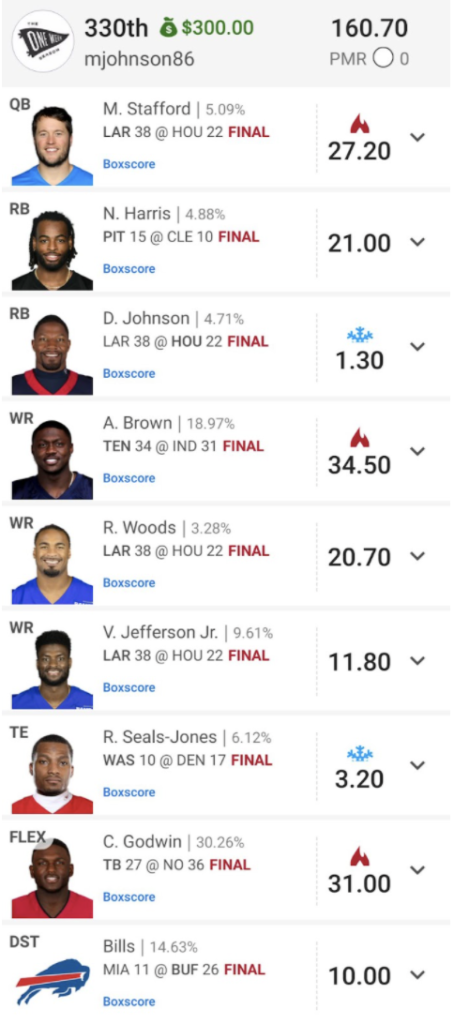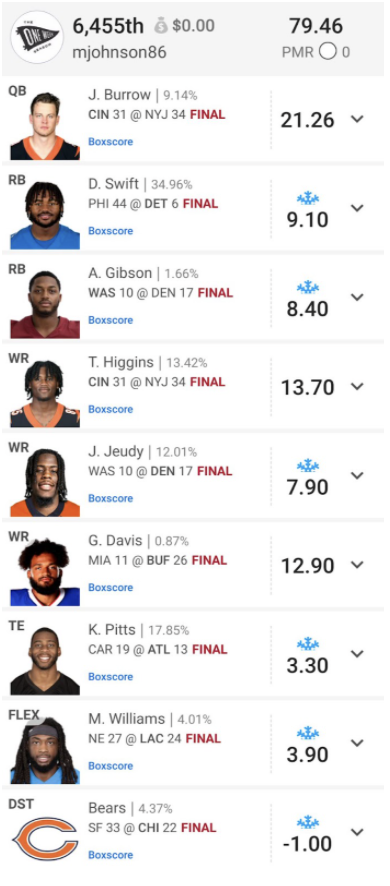Process Points. 9.21.
Lesson of the Week: Think Like A Coach
I am often asked the question, “what is it that makes you good at DFS?” There are a lot of things that go into DFS success, but what I believe is one of the things I am best at is being able to “think like a coach.” What I mean by that is that football is a game played by humans, who are fallible, and decisions made by coaches have a far greater impact on the outcome of games than in almost any other sport. The use of statistics and analytics can be great and very predictive, but understanding the human elements that could alter those projections can have a huge impact on how you evaluate plays and being able to see angles that won’t show up on a spreadsheet. Here are a few examples of “thinking like a coach” from Week 9 and things that wouldn’t naturally show up from looking at box scores but make sense from a coaching and theory perspective:
- Seahawks passing game: I touched on this in the NFL Edge writeup for the game, but the Seahawks *had* to win that game. While coaches (and especially Pete Carroll) try to have an identity, when they are backed into a corner, ultimately the best thing to do is rely on your best players (see how often they’ve turned Russ loose in the 2nd half of games that he goes out and wins for them after being conservative early). In this spot against an awful Jaguars secondary that was going to load up in anticipation of the run, it made a ton of sense for the Seahawks to rely on their best players — Tyler Lockett and DK Metcalf — to carry them rather than their ragtag bunch of running backs against stack boxes. Lockett and Metcalf combined for an insane 18 of Geno Smith’s 20 completions.
- Kyle Pitts without Calvin Ridley: Obviously, this was going to raise Pitts’ projections as, in theory, he would have a bigger role, but more importantly, his ownership was going to shoot up, and he would get a lot more defensive attention. If it was known early in the week that Ridley may be out, the Falcons likely would have spent a lot of time scheming things specifically for Pitts. On short notice, however, that is extremely hard to do, and it is much easier for the Panthers to give Pitts more attention than it is for the Falcons to scheme him open against more attention. Again, these are things that don’t just naturally show up on a spreadsheet when “projected target shares” get redistributed. Compare that to AJ Brown on the Titans without Julio Jones, who the Titans knew would be out all week, or Chris Godwin on the Bucs when they knew Antonio Brown would be out, Gronk would likely be limited, and Mike Evans would draw Lattimore.
- Darrell Henderson in a blowout: Henderson had played 80%+ snaps in every game this year where he didn’t leave with an injury. While we knew there was a chance of this game getting out of hand and him sitting for a decent portion of the second half, from a coaching perspective, this was a perfect time for McVay to get Sony Michel some extra work early and save the tread on Henderson — which is exactly what happened as Michel played an entire series in the 2nd quarter and had five first-half touches. Henderson still had a very good game, but it’s just another angle that deserves consideration that won’t show up on a spreadsheet. If we assume the Rams smash and score a lot of first-half points and that’s when Henderson needs to do his damage, losing one of their five first-half offensive possessions is a big ding to him. Michel had three runs for 10 yards and two receptions for 14 yards on that drive — which would have got Henderson to the 100-yard rushing bonus and given him an extra 7.4 DraftKings points.
- D’Andre Swift without Jamaal Williams: Obviously, Swift projecting for a lions’ share (no pun intended) of the work seems like a smash spot, and I did play a lot of him. However, there’s something to think about in spots like this, as sometimes players thrive in certain roles for a reason. A player like Swift, who is so explosive and dynamic, may actually be more effective when he gets more rest and is fresh on the touches he does get. There can be diminishing returns on players like him where if they get run down. The extra volume doesn’t make up for losing some likelihood of explosive plays. Given the massive impact in ownership he saw when Williams was ruled out, the risk of the offense being hurt and Swift not making big plays was a big deal.
- Robby Anderson: There is always the case of “missed air yards” and players who have seen a lot of targets but haven’t done much with them. On a spreadsheet, those players are going to project as great regression candidates. From a coaching perspective, however, there is going to be a breaking point when a secondary player on your team is consistently failing to produce with the opportunities you are giving him. I am definitely someone who looks for players who have disappointed and tries to attack them while the field is down on them, but a player like Robby (who isn’t the focal point of the offense) was just as likely, or even more likely, to have that volume cut by his coaches as he is to all of a sudden have a huge game.
These are just a few examples of ways we can think outside the spreadsheet and box scores to make decisions and try to gain an edge. It is easy to overthink these things sometimes, but there are usually a few situations each week where things just “make sense” if we think deeply about them that aren’t going to project a certain way. As we approach the midway point in the season and coaches fight for their jobs, teams adjust to injuries, young players show themselves as deserving of more opportunity, and older players show themselves to be nearing the end, there will be a lot of chances for us to “think like a coach” and see the things that “make sense” before they happen.
Lineup Reviews
As outlined in my +EV Primer course (you can find in the Marketplace – either by itself or in the bundle with my player pool course), one of my approaches that keeps me from getting too high or low week-to-week is playing consistent contests and approaching them from a season-long perspective and using that to evaluate my play and ROI. This season, in this article, I will be tracking my progress on a weekly basis as I play the Single Entry (SE), 3-max, and 5-max tournaments in the $20 to $150 price range on DraftKings main slate for all 18 weeks. Rather than sweating or worrying about my ROI every week and “hoping to cash,” – my goal for the season is to maximize profit relative to that long-term investment total. The results of a given week are irrelevant.
Each week I will review the best and worst of my 11 lineups from my “Roster Block” of SE/3-Max/5-Max. Below are this week’s results, and you can find more information about my process/theory for this in my Week 1 Process Points article.
Best Lineup ($600k Power Sweep, 3-Max, $150)

The “story” I was telling: I loved everything about this lineup except one player….David Johnson. The thought process was that with Mark Ingram out of town and Houston likely to trail, he’d be the preferred pass down back. This is an instance of having no reason to force a bring back (which I always preach), but falling into the trap of something that may “make sense” in some ways but likely limits my ceiling and likelihood of a first-place finish. I would have been much better off moving down from RSJ and BUF D to the really cheap TE and DEF options like Arnold and WAS D — that would have allowed me to move off Johnson to a RB in the low $6k range. I was very happy getting the Rams passing game, which was very likely to lead the slate in TDs, double stacked with sub-10% ownership from each piece. Najee, AJ Brown, and Godwin were three of my favorite plays of the week for their locked-in volume due to their roles and with teammates who would be out, so I wasn’t worried about ownership there, but Najee at sub-5% was a nice bonus.
Worst Lineup ($300K Red Zone, Single Entry, $50):

The “story” I was telling: I know winter is coming, but that sure is a lot of snowflakes!! The Burrow/Higgins pairing is something I wanted exposure to in that matchup with the Jets. I wasn’t confident in a Jets bring back, which looks like a mistake in hindsight, but I was very wary of Mike White being able to move the team — kudos to him for a great performance. This lineup looked very different prior to the late inactive news as I moved to Pitts and Swift at that point. The Gibson/Jeudy correlation was a leap of faith on the game environment turning fruitful and a couple of players seemingly better from injury — Jeudy in his first game since Week 1 against the worst (or close to it) secondary in the league, and Gibson, who wasn’t on the Friday injury report at all, so I thought there was a decent chance he returned to a normal workload in a game against a team without its top six linebackers.
Week 8 Results: This week, I cashed two of my 11 lineups for $450 total. Certainly not my greatest week, but continuing to learn and grow from my mistakes. Excited for Week 9!
Week 8 Investment: $792
Week 8 Winnings: $450
Estimated Yearly Investment: $14,000
Yearly Winnings: $3,180
